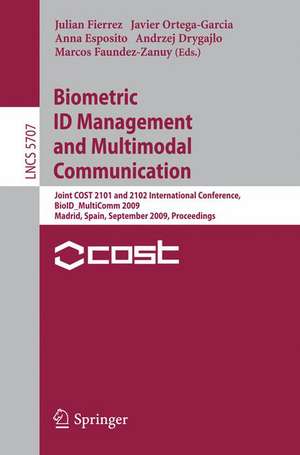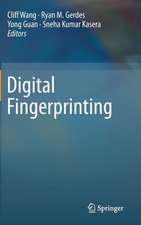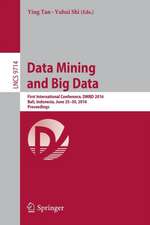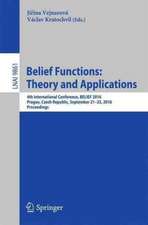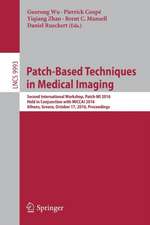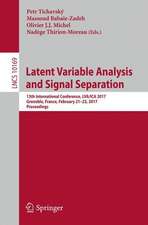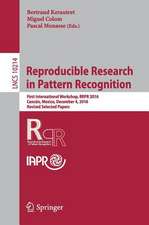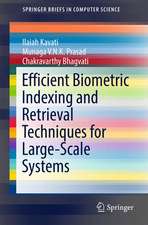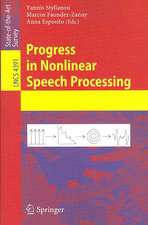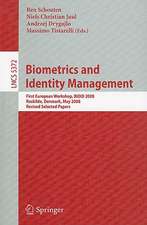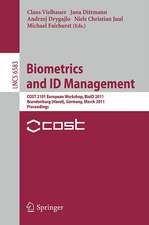Biometric ID Management and Multimodal Communication: Joint COST 2101 and 2102 International Conference, BioID_MultiComm 2009, Madrid, Spain, September 16-18, 2009, Proceedings: Lecture Notes in Computer Science, cartea 5707
Editat de Julian Fierrez, Javier Ortega-Garcia, Anna Esposito, Andrzej Drygajlo, Marcos Faundez-Zanuyen Limba Engleză Paperback – 7 sep 2009
Din seria Lecture Notes in Computer Science
- 20%
 Preț: 1061.55 lei
Preț: 1061.55 lei - 20%
 Preț: 307.71 lei
Preț: 307.71 lei - 20%
 Preț: 438.69 lei
Preț: 438.69 lei - 20%
 Preț: 645.28 lei
Preț: 645.28 lei -
 Preț: 410.88 lei
Preț: 410.88 lei - 15%
 Preț: 580.46 lei
Preț: 580.46 lei - 17%
 Preț: 427.22 lei
Preț: 427.22 lei - 20%
 Preț: 596.46 lei
Preț: 596.46 lei -
 Preț: 449.57 lei
Preț: 449.57 lei - 20%
 Preț: 353.50 lei
Preț: 353.50 lei - 20%
 Preț: 1414.79 lei
Preț: 1414.79 lei - 20%
 Preț: 309.90 lei
Preț: 309.90 lei - 20%
 Preț: 583.40 lei
Preț: 583.40 lei - 20%
 Preț: 1075.26 lei
Preț: 1075.26 lei - 20%
 Preț: 310.26 lei
Preț: 310.26 lei - 20%
 Preț: 655.02 lei
Preț: 655.02 lei - 20%
 Preț: 580.93 lei
Preț: 580.93 lei - 20%
 Preț: 340.32 lei
Preț: 340.32 lei - 18%
 Preț: 938.83 lei
Preț: 938.83 lei - 20%
 Preț: 591.51 lei
Preț: 591.51 lei - 15%
 Preț: 438.59 lei
Preț: 438.59 lei - 20%
 Preț: 337.00 lei
Preț: 337.00 lei -
 Preț: 389.48 lei
Preț: 389.48 lei - 20%
 Preț: 607.39 lei
Preț: 607.39 lei - 20%
 Preț: 1024.44 lei
Preț: 1024.44 lei - 20%
 Preț: 579.30 lei
Preț: 579.30 lei - 20%
 Preț: 763.23 lei
Preț: 763.23 lei - 20%
 Preț: 453.32 lei
Preț: 453.32 lei - 20%
 Preț: 575.48 lei
Preț: 575.48 lei - 20%
 Preț: 585.88 lei
Preț: 585.88 lei - 20%
 Preț: 825.93 lei
Preț: 825.93 lei - 20%
 Preț: 763.23 lei
Preț: 763.23 lei - 17%
 Preț: 360.19 lei
Preț: 360.19 lei - 20%
 Preț: 1183.14 lei
Preț: 1183.14 lei - 20%
 Preț: 340.32 lei
Preț: 340.32 lei - 20%
 Preț: 504.57 lei
Preț: 504.57 lei - 20%
 Preț: 369.12 lei
Preț: 369.12 lei - 20%
 Preț: 583.40 lei
Preț: 583.40 lei - 20%
 Preț: 343.62 lei
Preț: 343.62 lei - 20%
 Preț: 350.21 lei
Preț: 350.21 lei - 20%
 Preț: 764.89 lei
Preț: 764.89 lei - 20%
 Preț: 583.40 lei
Preț: 583.40 lei - 20%
 Preț: 649.49 lei
Preț: 649.49 lei - 20%
 Preț: 341.95 lei
Preț: 341.95 lei - 20%
 Preț: 238.01 lei
Preț: 238.01 lei - 20%
 Preț: 538.29 lei
Preț: 538.29 lei
Preț: 337.85 lei
Preț vechi: 422.31 lei
-20% Nou
Puncte Express: 507
Preț estimativ în valută:
64.65€ • 67.64$ • 53.70£
64.65€ • 67.64$ • 53.70£
Carte tipărită la comandă
Livrare economică 02-16 aprilie
Preluare comenzi: 021 569.72.76
Specificații
ISBN-13: 9783642043901
ISBN-10: 3642043909
Pagini: 360
Ilustrații: XIII, 358 p.
Dimensiuni: 155 x 235 x 25 mm
Greutate: 0.57 kg
Ediția:2009
Editura: Springer Berlin, Heidelberg
Colecția Springer
Seriile Lecture Notes in Computer Science, Image Processing, Computer Vision, Pattern Recognition, and Graphics
Locul publicării:Berlin, Heidelberg, Germany
ISBN-10: 3642043909
Pagini: 360
Ilustrații: XIII, 358 p.
Dimensiuni: 155 x 235 x 25 mm
Greutate: 0.57 kg
Ediția:2009
Editura: Springer Berlin, Heidelberg
Colecția Springer
Seriile Lecture Notes in Computer Science, Image Processing, Computer Vision, Pattern Recognition, and Graphics
Locul publicării:Berlin, Heidelberg, Germany
Public țintă
ResearchCuprins
Face Processing and Recognition.- Illumination Invariant Face Recognition by Non-Local Smoothing.- Manifold Learning for Video-to-Video Face Recognition.- MORPH: Development and Optimization of a Longitudinal Age Progression Database.- Verification of Aging Faces Using Local Ternary Patterns and Q-Stack Classifier.- Voice Analysis and Modeling.- Recognition of Emotional State in Polish Speech - Comparison between Human and Automatic Efficiency.- Harmonic Model for Female Voice Emotional Synthesis.- Anchor Model Fusion for Emotion Recognition in Speech.- Multimodal Interaction.- Audiovisual Alignment in a Face-to-Face Conversation Translation Framework.- Maximising Audiovisual Correlation with Automatic Lip Tracking and Vowel Based Segmentation.- Visual Context Effects on the Perception of Musical Emotional Expressions.- Eigenfeatures and Supervectors in Feature and Score Fusion for SVM Face and Speaker Verification.- Face and Expression Recognition.- Facial Expression Recognition Using Two-Class Discriminant Features.- A Study for the Self Similarity Smile Detection.- Analysis of Head and Facial Gestures Using Facial Landmark Trajectories.- Combining Audio and Video for Detection of Spontaneous Emotions.- Face Recognition Using Wireframe Model Across Facial Expressions.- Body and Gait Recognition.- Modeling Gait Using CPG (Central Pattern Generator) and Neural Network.- Fusion of Movement Specific Human Identification Experts.- CBIR over Multiple Projections of 3D Objects.- Biometrics beyond the Visible Spectrum: Imaging Technologies and Applications.- Poster Session.- Formant Based Analysis of Spoken Arabic Vowels.- Key Generation in a Voice Based Template Free Biometric Security System.- Extending Match-On-Card to Local Biometric Identification.- A New Fingerprint Matching Algorithm Based on Minimum Cost Function.- Invariant Fourier Descriptors Representation of Medieval Byzantine Neume Notation.- Bio-Inspired Reference Level Assigned DTW for Person Identification Using Handwritten Signatures.- Pressure Evaluation in On-Line and Off-Line Signatures.- Confidence Partition and Hybrid Fusion in Multimodal Biometric Verification System.- Multi-biometric Fusion for Driver Authentication on the Example of Speech and Face.- Multi-modal Authentication Using Continuous Dynamic Programming.- Biometric System Verification Close to “Real World” Conditions.- Developing HEO Human Emotions Ontology.- Common Sense Computing: From the Society of Mind to Digital Intuition and beyond.- On Development of Inspection System for Biometric Passports Using Java.- Handwritten Signature On-Card Matching Performance Testing.- Classification Based Revocable Biometric Identity Code Generation.- Vulnerability Assessment of Fingerprint Matching Based on Time Analysis.- A Matching Algorithm Secure against the Wolf Attack in Biometric Authentication Systems.- A Region-Based Iris Feature Extraction Method Based on 2D-Wavelet Transform.- A Novel Contourlet Based Online Fingerprint Identification.- Fake Finger Detection Using the Fractional Fourier Transform.- Comparison of Distance-Based Features for Hand Geometry Authentication.- A Comparison of Three Kinds of DP Matching Schemes in Verifying Segmental Signatures.- Ergodic HMM-UBM System for On-Line Signature Verification.- Improving Identity Prediction in Signature-based Unimodal Systems Using Soft Biometrics.
Textul de pe ultima copertă
This book constitutes the research papers presented at the Joint 2101 & 2102 International Conference on Biometric ID Management and Multimodal Communication.
BioID_MultiComm'09 is a joint International Conference organized cooperatively by COST Actions 2101 & 2102. COST 2101 Action is focused on "Biometrics for Identity Documents and Smart Cards (BIDS)", while COST 2102 Action is entitled "Cross-Modal Analysis of Verbal and Non-verbal Communication".
The aim of COST 2101 is to investigate novel technologies for unsupervised multimodal biometric authentication systems using a new generation of biometrics-enabled identity documents and smart cards.
COST 2102 is devoted to develop an advanced acoustical, perceptual and psychological analysis of verbal and non-verbal communication signals originating in spontaneous face-to-face interaction, in order to identify algorithms and automatic procedures capable of recognizing human emotional states.
BioID_MultiComm'09 is a joint International Conference organized cooperatively by COST Actions 2101 & 2102. COST 2101 Action is focused on "Biometrics for Identity Documents and Smart Cards (BIDS)", while COST 2102 Action is entitled "Cross-Modal Analysis of Verbal and Non-verbal Communication".
The aim of COST 2101 is to investigate novel technologies for unsupervised multimodal biometric authentication systems using a new generation of biometrics-enabled identity documents and smart cards.
COST 2102 is devoted to develop an advanced acoustical, perceptual and psychological analysis of verbal and non-verbal communication signals originating in spontaneous face-to-face interaction, in order to identify algorithms and automatic procedures capable of recognizing human emotional states.
